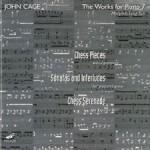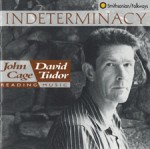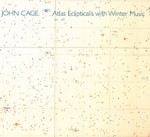Column Name
Title
Perhaps no other composer has so sharply divided listeners—as much for his philosophy as for his compositions—as John Cage (1912-1992), whose centennial will be celebrated at the upcoming Focus! festival at Juilliard, which runs from January 27 through February 3. Listeners unfamiliar with Cage’s prolific output will be startled by his playfulness, his upending of convention, cheerful embrace of chance operations, and vigorous belief in the possibilities inherent in everything we hear; Cage is the godfather of sounds some might characterize as “nonmusical.”
Body
Getting into Cage is almost impossible without dipping into the massive cycle on Mode Records masterminded by the label’s founder, Brian Brandt, who has created one of the largest catalogs of Cage’s work (43 volumes to date). Perhaps one of the composer’s best-known scores is Sonatas and Interludes for prepared piano (1946-48), which Mode has recorded twice. In the earlier version (Mode 50, 1996), Philipp Vandré used a Steinway “O” piano—the original model for which Cage conceived the piece and for which he specifies very precise placement of the items touching the strings (bolts, screws, plastic, rubber, an eraser). Traditional piano timbre is nowhere to be found; in its place is a subtle universe of muted bongos and damped gongs; some notes even sound electronic. In the later recording (Mode 158, 2006), Margaret Leng Tan, the first woman to receive a doctorate at Juilliard, in 1971, opted for a powerful Steinway “D,” with longer strings that give each note a more resonant charge (and required commensurate adjustments in the placement of the hardware).
Cage scholar and author of The Music of John Cage (Cambridge University Press, 1996) James Pritchett calls Indeterminacy (Smithsonian/Folkways SF 40804/5) “the one absolutely must-have Cage recording,” an opinion that’s shared by composer David Lang. Originally issued in 1959, this groundbreaking set has Cage himself (in a voice oddly reminiscent of Vincent Price) reciting 90 one-minute vignettes in one room, while in an adjacent space, pianist David Tudor plays recordings of Cage’s Concert for Piano and Orchestra (1957-58) and Fontana Mix (1958-59). At times Cage’s tone seems disengaged, like those computer-generated voices found on contemporary telephone menus; at others it’s hard not to laugh at his understated wit. Sometimes the narrative spills out in torrents; at others Cage surrounds each word with its own space. This serendipitous convergence of text and sound—a sort of democracy of elements—was one of his most audacious conceptions and an aesthetic cornerstone: that no sound is inherently “better” than any other, and therefore, all sounds are equally useful, and by implication, attractive. (In his notes, Richard Kostelanetz deems it “perfectly appropriate” to combine other sounds with these, so one night I tested the waters by adding some televised evening news. After adjusting the volume so that the sound sources were approximately equal in strength—though Cage would argue that there is no “right” mix—I sat back and bathed in the newly created cacophony, punctuated by Tudor’s nearby bursts of music.)
Cage’s first orchestral piece, Atlas Eclipticalis (1961), was written for any size ensemble, using chance operations (the compositional technique he adopted in the early 1950s) inflected by the positions of stars in the night sky. At a series of New York Philharmonic subscription concerts in 1964, Leonard Bernstein caused a sensation (to put it diplomatically) when he programmed Atlas Eclipticalis with works by Morton Feldman and Earle Brown following a first half of Vivaldi and Tchaikovsky. Mode 3/6 (three discs) presents two different versions, both recorded live in the 1980s: one for full orchestra, and a second for chamber ensemble, conducted by Cage himself who performs it with the optional Winter Music (1957). And on Mode 160, Ulrich Krieger offers still another version for three soprano saxophones and electronics. But on a Deutsche Grammophon disc (DG 431-698-2) with works by Babbitt, Carter, and Schuller, James Levine and the Chicago Symphony Orchestra (who almost never delve into this corner of the repertory) give a rare, fascinating chance to hear a seminal Cage experiment with one of the world’s great orchestras led by one of the world’s most lucid musical minds.
The work of Joan La Barbara—a thinking person’s vocalist and one of the world’s pre-eminent Cage champions— makes essential listening. Coincidentally, at a recent event honoring Juilliard’s provost and dean, Ara Guzelimian, La Barbara not only introduced him but performed a set of Cage songs. Later I asked Guzelimian to name his favorite Cage recording and La Barbara’s Singing Through (New Albion NA035) was his reply. In this mostly a cappella collection, she deploys luminous, pitch-perfect tone in texts from sources as diverse as Henry David Thoreau, James Joyce, Marcel Duchamp, and the Bible. The nine brief sections of Sonnekus (1985) are interrupted by three cabaret songs by Satie. And crickets lurk in the background of Song No. 67 (1970), with La Barbara going from guttural lunges to a yappy bark, to which a construction site pile driver adds a deadpan counterpoint.
Afterward, I wrote to La Barbara, asking if she would name one of her favorite Cage recordings, and she mentioned another piano collection from Margaret Leng Tan, Daughters of the Lonesome Isle (New Albion NA070). Written in 1945 for dancer-choreographer Jean Erdman, the title track (for prepared piano) shows Cage again transforming a familiar instrument into something enticingly alien, as Tan writes, “a percussion orchestra under the control of a single player.” And the 1948 Suite for Toy Piano makes masterful use of an instrument some might think offers limited possibilities, turning it into one that transfixes the listener with its tiny, yet utterly compelling, universe.







